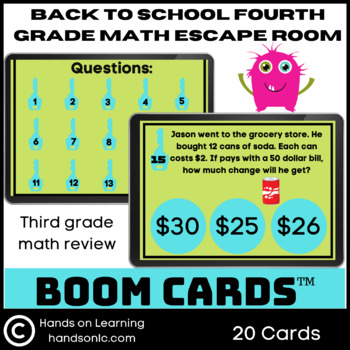Back to School Fourth Grade Escape Room Boom Cards
- PDF
- Internet Activities
What educators are saying
Description
Back to School Math Review Boom Cards
Welcome your fourth grade students by reviewing third grade math with this review escape room. Students will review place value, money, time, addition, multiplication, division, word problems, graphs, shapes, and measurement.
This is designed to be an end of the year review for third grade, or beginning of the year for fourth grade students.
Play preview here
Highlights
➼ Self-Grading and interactive
➼ Practice third grade math skills
➼ Engaging review or practice
What’s included:
There are 22 cards in this deck to review key third grade math skills.
How to use this product:
Link will come in a PDF for single computer use only
Standard Boom Terms:
To use Boom Cards, you must be connected to the Internet. Boom Cards play on modern browsers (Chrome, Safari, Firefox, and Edge). Apps are available for Android, iPads, iPhones, and Kindle Fires. For security and privacy, adults must have a Boom Learning account to use and assign Boom Cards. You will be able to assign the Boom Cards you are buying with "Fast Pins," (play provides instant feedback for self-grading Boom Cards). Fast Play is always a free way for students to engage with Boom Cards decks. For additional assignment options you'll need a premium account. If you are new to Boom Learning, you will be offered a free trial of our premium account. Readhere for details: http://bit.ly/BoomTrial.
You may be eligible for a free trial from Boom Learning. Read here for details: http://bit.ly/BoomTrial. If you choose not to stay on a premium account after your free trial, you will still be able to assign all your Boom Cards to as many students as you see fit using Fast Play pins (which give instant feedback for decks that are self-grading).
Additional information
▀ Make sure you have a Boom Learning account prior to purchasing
▀ Fast pins will randomize 20 cards. To access all cards, select all (Boom defaults to 20 cards)
………………………………………………………………………………………………………..
Related Resources:
➯Third grade math digital interactive notebook
Follow me for updates and new products >>> Click Here
Want TPT credits? Don’t forget to leave a review. >>>
For questions, typos, or clarification email me at >>> handsonlearningcenterga@gmail.com
© Hands on Learning, LLC 2020





